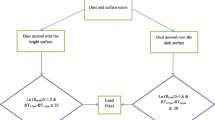Abstract
For any satellite-based study, ground-based reflectance values are required. Nowadays, these ground-based reflectance products are provided by all the major space agencies, commonly designated as level 2 products. However, the availability of the level 2 products takes some time and once in a while, these products are not available. For the development of near real-time monitoring systems, this poses a major problem, and thus it becomes necessary to correct the raw satellite imagery by using atmospheric correction techniques. The Dark Object Subtraction technique (DOS) is one such commonly used technique used previously in many studies. However, it requires the manual selection of the darkest pixels in the imagery, thus making it unsuitable for automation-based systems. This study aims to automate the process of Dark Object Subtraction Sentinel 2A raw satellite imageries within the Google Earth Engine platform. Mean annual LULC maps generated using automated Dark Object Subtraction could replicate the level 2 product quite accurately. These classified imageries for July 2018−July 2019 produced overall classification accuracies of 74.13 and 67.24% using Random Forest Classifier and Support Vector Machines, respectively, compared to 68.96% obtained for both the classification algorithms using level 2 products. In the period July 2019−July 2020, it was obtained as 81.03 and 77.58%, respectively, compared to 79.31% for the same, and for July 2020- July 2021, it was 72.41 and 68.96% against 68.96 and 67.24%. The automated Dark Object Subtraction technique can thus be employed to develop near real-time automated satellite imagery-based systems within the Google Earth Engine platform.
Access this chapter
Tax calculation will be finalised at checkout
Purchases are for personal use only
Similar content being viewed by others
References
Adams JB, Gillespie AR (2006) Remote sensing of landscapes with spectral images: A physical modeling approach. Cambridge University Press
Ahern FJ, Goodenough DG, Jain SC, Rao VR, Rochon G (1977) Use of clear lake as standard reflectors for atmospheric measurement. In: ERIM Proc. of the 11th Intern Symp on Remote Sensing of Environment, vol 1
Breiman L (2001) Random forests. Mach Learn 45(1):5-32
Chavez PS Jr (1988) An improved dark-object subtraction technique for atmospheric scattering correction of multispectral data. Remote Sens Environ 24(3):459–479
Chavez PS (1996) Image-based atmospheric corrections-revisited and improved. Photogramm Eng Remote Sens 62(9):1025–1035
Ding H, Shi J, Wang Y, Wei L (2015) An improved dark-object subtraction technique for atmospheric correction of Landsat 8. In: MIPPR 2015: Remote sensing image processing, geographic information systems, and other applications, vol 9815. SPIE, pp 128–135
Dozier J, Frew J (1981) Atmospheric corrections to satellite radiometric data over rugged terrain. Remote Sens Environ 11:191–205
Gao J (2009) Digital analysis of remotely sensed imagery. McGraw-Hill Education
Kneizys FX (1988) Users guide to LOWTRAN 7 (No. 1010). Air Force Geophysics Laboratory, United States Air Force
Lillesand T, Kiefer RW, Chipman J (2015) Remote sensing and image interpretation. John Wiley & Sons
Li Z, Duan P, Hu S, Li M, Kang X (2022) Fast hyperspectral image dehazing with dark-object subtraction model. IEEE Geosci Remote Sens Letters
Moran MS, Jackson RD, Slater PN, Teillet PM (1992) Evaluation of simplified procedures for retrieval of land surface reflectance factors from satellite sensor output. Remote Sens Environ 41(2–3):169–184
Mustak S (2013) Correction of atmospheric haze in Resourcesat-1 Liss-4 Mx Data for urban analysis: an improved dark object subtraction approach. Int Arch Photogramm, Remote Sens Spat Inf Sci 1:W3
Otterman J, Fraser RS (1976) Earth-atmosphere system and surface reflectivities in arid regions from Landsat MSS data. Remote Sens Environ 5:247–266
Richter R (1990) A fast atmospheric correction algorithm applied to Landsat TM images. Title Remote Sens 11(1):159–166
Rowan LC, Wetlaufer PH, Stewart JH (1976) Discrimination of rock types and detection of hydrothermally altered areas in south-central Nevada by the use of computer-enhanced ERTS images
Singh SM (1988) Estimation of multiple reflection and lowest order adjacency effects on remotely-sensed data. Int J Remote Sens 9(9):1433–1450
Vapnik V (1999) The nature of statistical learning theory. Springer science & business media
Vincent R (1973) An ERTS multispectral scanner experiment for map** iron compounds
Wicaksono P, Hafizt M (2018) Dark target effectiveness for dark-object subtraction atmospheric correction method on mangrove above-ground carbon stock map**. IET Image Proc 12(4):582–587
Author information
Authors and Affiliations
Corresponding author
Editor information
Editors and Affiliations
Rights and permissions
Copyright information
© 2023 The Author(s), under exclusive license to Springer Nature Singapore Pte Ltd.
About this paper
Cite this paper
Kakati, R., Dwivedy, S.K., Dutta, S. (2023). Development of a Fully Automated Atmospheric Correction Technique for Applications in Google Earth Engine. In: Dutta, S., Chembolu, V. (eds) Recent Development in River Corridor Management. RCRM 2022. Lecture Notes in Civil Engineering, vol 376. Springer, Singapore. https://doi.org/10.1007/978-981-99-4423-1_24
Download citation
DOI: https://doi.org/10.1007/978-981-99-4423-1_24
Published:
Publisher Name: Springer, Singapore
Print ISBN: 978-981-99-4422-4
Online ISBN: 978-981-99-4423-1
eBook Packages: EngineeringEngineering (R0)




